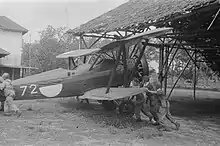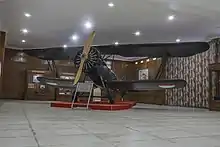Yokosuka K5Y
The Yokosuka K5Y (九三式中間練習機, Kyūsanshikichūkanrenshūki, Type 93 Intermediate Training Aircraft, Allied reporting name: "Willow") was a two-seat unequal-span biplane trainer that served in the Imperial Japanese Navy during World War II. Due to its bright orange paint scheme (applied to all Japanese military trainers for visibility), it earned the nickname "aka-tombo", or "red dragonfly", after a type of insect common throughout Japan.
| K5Y | |
|---|---|
 | |
| K5Y1 | |
| Role | Intermediate trainer |
| Manufacturer | Various, see text |
| First flight | 1933 |
| Introduction | 1934 |
| Primary user | Imperial Japanese Navy Air Service |
| Produced | 1934-1945 |
| Number built | 5,770 |
A K5Y of the Kamikaze Special Attack Corps 3rd Ryuko Squadron was credited with sinking the destroyer USS Callaghan on July 28, 1945, the last US warship lost to kamikaze attack during the war.[1]
Design and development
The aircraft was based on the Yokosuka Navy Type 91 Intermediate Trainer, but stability problems led to a redesign by Kawanishi in 1933. It entered service in 1934 as Navy Type 93 Intermediate Trainer K5Y1 with fixed tail-skid landing gear, and remained in use throughout the war. Floatplane types K5Y2 and K5Y3 were also produced. After the initial 60 examples by Kawanishi, production was continued by Watanabe (556 aircraft built), Mitsubishi (60), Hitachi (1,393), First Naval Air Technical Arsenal (75), Nakajima (24), Nippon (2,733), and Fuji (896), for a total of 5,770. These aircraft were the mainstay of Imperial Japanese Navy Air Service's flight training, and as intermediate trainers, they were capable of performing demanding aerobatic maneuvers. Two further land-based versions, the K5Y4 with a 358 kW (480 hp) Amakaze 21A engine and the K5Y5 with a 384 kW (515 hp) Amakaze 15, were projected but never built.[2]
Variants

- K5Y1
- Two-seat intermediate trainer for the Imperial Japanese Navy.
- K5Y2
- Floatplane version, with Amakaze 11 engine.
- K5Y3
- Floatplane, with 384 kW (515 hp) Amakaze 21.
- K5Y4
- Projected land-based version with 358 kW (480 hp) Amakaze 21A. Never built.
- K5Y5
- Projected land-based version with 384 kW (515 hp) Amakaze 15. Never built.
Operators
Postwar


- Indonesian People's Security Agency and later Indonesian Air Force operated derelict aircraft against Dutch colonial rule. On July 29 1947, the Indonesians using 2 units of Yokosuka K5Y (Called "Cureng/Churen" by Indonesian fighters) with one "Guntei Bomber" (Mitsubishi Ki-51) from Maguwo Air Force Base, Yogyakarta for bombing Dutch strategic positions in Ambarawa, Salatiga and Semarang. On its original plan, Nakajima Ki-43 "Hayabusa" also planned to be involved too in this operation, but cancelled as the aircraft suffered technical difficulties. It is currently on display at Yogyakarta (Dirgantara Mandala Museum).
Specifications (K5Y2 floatplane)
Data from Japanese Aircraft of the Pacific War[3]
General characteristics
- Crew: 2
- Length: 8.78 m (28 ft 10 in)
- K5Y1: 8.05 m (26 ft)
- Wingspan: 11 m (36 ft 1 in)
- Height: 3.68 m (12 ft 1 in)
- K5Y1: 3.2 m (10 ft)
- Wing area: 27.7 m2 (298 sq ft)
- Empty weight: 1,130 kg (2,491 lb)
- K5Y1: 1,000 kg (2,205 lb)
- Gross weight: 1,650 kg (3,638 lb)
- K5Y1: 1,500 kg (3,307 lb)
- Powerplant: 1 × Hitachi Amakaze 11 9-cylinder air-cooled radial piston engine, 250 kW (340 hp) for take-off
- 300 hp (224 kW) normal at sea level
- Propellers: 2-bladed wooden fixed-pitch propeller
Performance
- Maximum speed: 200 km/h (120 mph, 110 kn) at sea level
- K5Y1: 213 km/h (132 mph; 115 kn)
- Cruise speed: 139 km/h (86 mph, 75 kn) at 1,000 m (3,281 ft)
- Range: 702 km (436 mi, 379 nmi)
- K5Y1: 1,018 km (633 mi; 550 nmi)
- Service ceiling: 4,330 m (14,210 ft)
- K5Y1: 5,700 m (18,701 ft) in
- Time to altitude: 3,000 m (9,843 ft) in 19 minutes 35 seconds
- K5Y1: 3,000 m (9,843 ft) in 13 minutes 32 seconds
- Wing loading: 59.6 kg/m2 (12.2 lb/sq ft)
- Power/mass: 0.1537 kW/kg (0.0935 hp/lb)
Armament
- Guns: 1× fixed, forward-firing 7.7 mm (.303 in) Type 97 aircraft machine gun and 1× flexible, rearward-firing 7.7 mm (.303 in) Type 92 machine gun
- Bombs: Up to 100 kg (220 lb) of bombs on external racks
Notes
- Miranda, Justo (2017). Axis Suicide Squads: German and Japanese Secret Projects of the Second World War. England: Fonthill Media. p. 158. ISBN 9781781555651.
- Francillon 1970, p. 446.
- Francillon 1970, p. 448.
Bibliography
- Collier, Basil. Japanese Aircraft of World War II. London: Sidgwick & Jackson, 1979. ISBN 0-283-98399-X.
- Douglas, A. D. (1977). "Talkback". Air Enthusiast. No. 3. p. 84. ISSN 0143-5450.
- Francillon, René J. (1970). Japanese Aircraft of the Pacific War. London: Putnam & Company Ltd. ISBN 0-370-00033-1.
- Mondey, David. The Concise Guide to Axis Aircraft of World War II. London: Chancellor Press, 1996. ISBN 1-85152-966-7.
- Tagaya, Osamu. Imperial Japanese Naval Aviator, 1937-45. Botley, Oxfordshire, UK: Osprey Publishing, 2003. ISBN 1-84176-385-3.
- Victor, P. C. (1977). "Talkback". Air Enthusiast. No. 3. p. 84. ISSN 0143-5450.